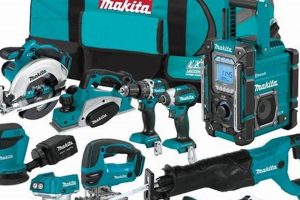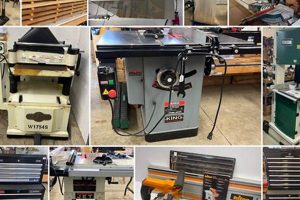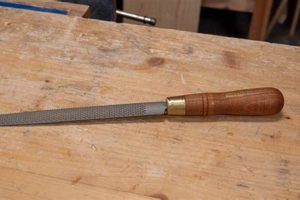Implements utilized in shaping and manipulating wood, manageable with a single hand or pair of hands, represent a core component of woodworking. Examples include saws, planes, chisels, and marking gauges, each designed for precise material removal or shaping without reliance on external power sources.
The reliance on manual skill and dexterity when employing these implements fosters a deeper connection with the material and allows for nuanced control over the final product. Their portability makes them ideal for on-site work and projects where access to power is limited. Throughout history, these instruments have been central to carpentry, joinery, and artistic woodcraft, enabling the creation of both functional and decorative objects.
The following discussion will explore specific categories of these tools, examining their function, maintenance, and application within various woodworking techniques. This encompasses both traditional and modern variations, shedding light on their enduring relevance in contemporary woodworking practices.
Essential Guidance for Using Manual Woodworking Implements
Proficient utilization of manual woodworking instruments demands a combination of proper technique, consistent maintenance, and a thorough understanding of material properties. The following recommendations aim to improve precision, safety, and the longevity of both the tools and the projects they facilitate.
Tip 1: Sharpening is Paramount: Regular honing of blades is critical for efficient cutting and minimizing the risk of injury. A dull edge necessitates increased force, leading to potential slippage and reduced control.
Tip 2: Grain Direction Matters: Always consider the direction of the wood grain. Cutting against the grain can result in tear-out and a rough surface. Plan to work with the grain whenever possible.
Tip 3: Secure Workholding: Firmly secure the workpiece using clamps or a vise. Movement during cutting can compromise accuracy and create hazardous situations.
Tip 4: Proper Stance and Grip: Adopt a stable stance and maintain a firm, comfortable grip on the implement. Distribute weight evenly and avoid overreaching.
Tip 5: Practice Consistent Technique: Repetitive movements should be smooth and controlled. Avoid jerky motions, which increase the likelihood of errors.
Tip 6: Regular Cleaning and Oiling: After each use, clean the implements to remove sawdust and debris. Apply a light coat of oil to prevent rust and corrosion.
Tip 7: Use Appropriate Protective Gear: Safety glasses are essential to protect against flying debris. Consider wearing gloves for enhanced grip and protection.
Adherence to these guidelines will promote efficient and safe utilization, leading to improved results and a more enjoyable woodworking experience. Mastering these fundamentals is crucial for both novice and experienced woodworkers.
The subsequent sections will delve into the specific applications of various types of these tools, building upon these foundational principles.
1. Precision
The inherent value of handheld woodworking tools resides significantly in their potential for achieving high degrees of precision. Unlike power tools, which can sometimes sacrifice fine control for speed, these instruments afford the operator direct tactile feedback and nuanced management of the cutting or shaping process. The level of accuracy achievable is directly proportional to the user’s skill, the tool’s sharpness, and the quality of its construction. A well-honed chisel, for example, allows for the paring of exceedingly thin shavings, enabling the creation of tight-fitting joints or the refinement of delicate details. Similarly, a meticulously adjusted hand plane can produce surfaces that are flat and true to within fractions of a millimeter.
The practical significance of this precision extends to all facets of woodworking. In furniture making, accurate joinery ensures structural integrity and aesthetic appeal. In instrument making, precise dimensions and contours are critical for achieving optimal sound quality. Even in rough carpentry, accurate layout and cutting minimize waste and ensure the proper fit of structural elements. The investment in quality implements and the dedication to mastering their use are therefore essential for achieving professional-grade results.
While the pursuit of precision with handheld tools presents challenges requiring patience, practice, and a thorough understanding of wood behavior the rewards are substantial. The ability to execute intricate designs, create seamless joints, and produce flawlessly finished surfaces is a testament to the power of skilled craftsmanship and the inherent accuracy of these tools. The enduring appeal of handheld woodworking lies in this ability to translate human intention into tangible form with unparalleled fidelity.
2. Ergonomics
Ergonomics, in the context of handheld woodworking tools, concerns the design and arrangement of these implements to optimize human well-being and overall system performance. A poorly designed tool can lead to discomfort, fatigue, and, in severe cases, musculoskeletal disorders. The relationship between tool design and physical strain is directly proportional; a tool with an awkward grip or excessive weight increases the force required for operation, accelerating fatigue and increasing the risk of injury. An example is a plane with a handle positioned at an unnatural angle, which can cause wrist strain during prolonged use. Prioritizing ergonomic design reduces these risks, promoting both productivity and the user’s long-term physical health.
The integration of ergonomic principles into handheld woodworking tools manifests in several key areas. Handle shape and size are crucial, allowing for a secure and comfortable grip that minimizes stress on the hand and wrist. Weight distribution is also a significant factor; a balanced tool requires less effort to control and reduces strain on specific muscle groups. Furthermore, features such as vibration dampening and textured surfaces can enhance grip and minimize fatigue. An illustration of this is a saw with a cushioned grip and optimized blade angle, which reduces vibration and minimizes the force needed for cutting. These considerations translate into improved efficiency, accuracy, and a reduced risk of occupational injury.
The understanding of ergonomics is vital for both manufacturers and users of handheld woodworking tools. Manufacturers must prioritize ergonomic design principles to create tools that are comfortable, efficient, and safe. Users should select tools that are appropriate for their hand size and strength, and they should be mindful of proper posture and technique to minimize strain. Challenges include balancing ergonomic considerations with tool functionality and cost. However, the long-term benefits of prioritizing ergonomics, including increased productivity, reduced healthcare costs, and improved user satisfaction, far outweigh the initial investment. Ultimately, the careful consideration of ergonomics is indispensable for sustainable and healthy woodworking practices.
3. Material Quality
The performance and longevity of handheld woodworking tools are intrinsically linked to the quality of materials used in their construction. The composition and treatment of metals, wood, and composite materials directly influence the tool’s ability to maintain an edge, withstand stress, and resist corrosion. For example, a chisel forged from high-carbon steel and properly tempered will retain its sharpness for an extended period and resist chipping, while a similar tool made from inferior steel will require frequent sharpening and be prone to damage. The same principle applies to wooden components; handles made from dense, stable hardwoods like beech or maple provide a secure and comfortable grip and resist splitting or warping, ensuring safe and precise tool control.
The impact of material quality extends beyond the tool’s immediate performance. A hand plane constructed with a precisely machined cast iron body will maintain its flatness and rigidity over time, allowing for consistent and accurate planing. Conversely, a plane made with a flimsy or poorly cast body will flex and vibrate, resulting in uneven cuts and increased user fatigue. Similarly, the screws, bolts, and adjustment mechanisms on a tool must be made from durable materials that resist wear and corrosion to ensure smooth and reliable operation. Investing in implements crafted from high-quality materials is, therefore, a cost-effective strategy, as these tools will provide superior performance, require less maintenance, and last significantly longer than their cheaper counterparts. The choice of materials directly affects the final product and woodworking experience.
In summary, material quality is a critical determinant of the effectiveness and durability of these implements. Understanding the properties of different materials and their suitability for various tool components is essential for selecting the right tools for the job and ensuring optimal performance. While initial cost may be higher, the long-term benefits of investing in quality implements outweigh the perceived savings of purchasing inferior tools. The commitment to material quality contributes directly to both the quality of the finished woodwork and the overall woodworking experience.
4. Maintenance
The sustained functionality and precision of handheld woodworking tools are directly contingent upon diligent maintenance practices. Neglecting routine care diminishes performance, accelerates wear, and increases the likelihood of unsafe operating conditions.
- Sharpening and Honing
Maintaining sharp cutting edges is paramount. Dull edges necessitate increased force, compromising control and potentially leading to injury. Regular sharpening, utilizing stones or specialized sharpening systems, restores the proper cutting angle. Honing, a supplementary process, refines the edge to a razor sharpness, enhancing cutting efficiency and minimizing tear-out on delicate woods.
- Cleaning and Lubrication
Accumulated sawdust, resin, and moisture promote corrosion and impede tool operation. Regular cleaning with a brush or cloth removes debris, while applying a light coat of oil protects metal surfaces from rust and facilitates smooth movement of adjustable components. Proper lubrication prevents seizing and ensures consistent performance.
- Handle Care and Preservation
Wooden handles, subject to dimensional changes due to humidity fluctuations, require periodic attention. Cleaning with a mild soap and water solution removes dirt and grime. Applying a protective finish, such as oil or wax, helps maintain moisture balance, preventing cracking and ensuring a comfortable and secure grip. Damage to handles can compromise tool control and safety.
- Rust Prevention and Removal
Exposed metal surfaces are susceptible to rust formation, particularly in humid environments. Regular inspection and proactive rust prevention measures are essential. Light rust can be removed with fine steel wool and oil. For more severe corrosion, specialized rust removal products may be necessary. Protecting cleaned surfaces with a rust-inhibiting coating safeguards against future damage.
Consistent adherence to these maintenance protocols ensures that these implements remain reliable, accurate, and safe for extended use. Neglecting such practices not only diminishes tool performance but also shortens their lifespan, representing a significant cost in the long term. The commitment to proper maintenance is therefore an integral aspect of responsible woodworking.
5. Technique
The effectiveness of handheld woodworking tools is inextricably linked to the operator’s technique. The instrument itself is merely a facilitator; the skill of the craftsperson dictates the precision, quality, and efficiency of the resulting work. Proper technique encompasses a range of factors, including stance, grip, tool angle, force application, and an understanding of the wood’s properties. A poorly executed technique can negate the inherent advantages of even the finest implement, resulting in inaccurate cuts, surface imperfections, and potential injury. For instance, a paring chisel, if held at an incorrect angle or forced against the grain, will produce a ragged edge instead of a clean, controlled cut. Similarly, a hand plane used with excessive pressure or without proper blade projection will gouge the surface and leave an uneven finish.
The mastery of technique necessitates dedicated practice and a thorough understanding of fundamental principles. Correct stance provides stability and control, while a firm, balanced grip allows for precise manipulation of the tool. The angle at which the tool engages the wood influences the cutting action, and the force applied must be appropriate for the task at hand. For example, when sawing a board to length, maintaining a consistent saw angle and applying even pressure ensures a straight, accurate cut. Furthermore, an understanding of wood grain direction is crucial for preventing tear-out and achieving smooth surfaces. The technique becomes even more critical when executing complex joinery, such as dovetails or mortise and tenon joints, where accuracy and precision are paramount. Learning and following safety guidance also an essential parts of the technique
In conclusion, technique is the indispensable complement to handheld woodworking tools. While the quality of the implement contributes to the potential for success, it is the skill and expertise of the operator that ultimately determine the outcome. The acquisition of proper technique requires diligent practice, a commitment to learning, and a willingness to adapt and refine one’s approach. The rewards are significant, resulting in improved efficiency, enhanced precision, and the satisfaction of producing high-quality woodworking projects. Ultimately, the symbiotic relationship between tool and technique defines the art of manual woodworking.
Frequently Asked Questions About Handheld Woodworking Tools
The following addresses common inquiries concerning the selection, use, and maintenance of handheld woodworking tools, clarifying key aspects of their application in various woodworking contexts.
Question 1: What factors should be considered when selecting a hand plane?
The selection of a hand plane should consider the intended application, the size and weight of the tool, the adjustability of the blade, and the quality of the materials. Smoother planes are designed for finishing surfaces, while jack planes are suited for rough stock removal. Blade adjustability is critical for precise control over cut depth.
Question 2: How frequently should chisels be sharpened?
Chisels should be sharpened as needed, based on the type of wood being worked and the frequency of use. A loss of sharpness is indicated by difficulty cutting and the need for increased force. Regular honing between sharpening sessions helps maintain the edge.
Question 3: What is the recommended method for removing rust from handheld woodworking tools?
Light surface rust can be removed with fine steel wool and oil. For heavier rust accumulation, a dedicated rust remover may be necessary, followed by thorough cleaning and application of a rust-preventative coating.
Question 4: How does wood grain direction affect the use of these implements?
Wood grain direction significantly impacts cutting quality. Cutting against the grain can lead to tear-out and a rough surface. Whenever possible, tools should be used in the direction of the grain to achieve smooth and controlled cuts.
Question 5: What safety precautions should be observed when using handheld woodworking tools?
Safety precautions include wearing eye protection, securing the workpiece, using sharp tools, and maintaining a firm grip. Dull tools require more force and increase the risk of slippage. A clear and well-lit workspace is also essential.
Question 6: What is the best way to store handheld woodworking tools to prevent damage?
Handheld woodworking tools should be stored in a dry environment to prevent rust and corrosion. Blades should be protected with blade guards or wrapped in cloth. Proper storage extends the tool’s lifespan and maintains its functionality.
Consistent application of the information presented ensures optimized utilization and prolonged durability, crucial for proficient woodworking practices.
The subsequent article section delves into advanced techniques that further refine skills, enhancing efficiency.
Conclusion
The preceding discussion has illuminated critical facets of handheld woodworking tools, encompassing their definition, proper utilization, material composition, maintenance requirements, and the vital role of technique. The emphasis has been on precision, ergonomics, material quality, and safety, underscoring the factors that contribute to successful woodworking outcomes and the prolonged lifespan of these implements.
A thorough understanding of these core principles empowers practitioners to make informed decisions regarding tool selection, application, and upkeep, ultimately fostering a deeper appreciation for the craft and enabling the creation of enduring, high-quality woodworking projects. The continued study and refinement of these skills remain essential for preserving the legacy of manual woodworking.







